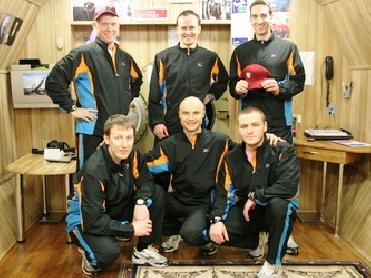
The Mars500 crew at the halfwaypoint of their mission. Photo Credit: ESA
MOSCOW (BNS): Six volunteers from Russia and Europe on Thursday emerged from a capsule inside a Moscow research facility where they had been locked away for the last three months to simulate a mission to Mars.
The six stepped out of the module smiling and in apparent good health after 105 days cut off from the outside world at the isolation facility at the Russian Institute for Biomedical Problems (IBMP).
At precisely 1000 GMT, an engineer removed the lock, cut the seal and the all-male team stepped outside the capsule that had been their home for the last three months.
Dressed in blue overalls like real-life spacemen, the four Russians, a Frenchman and a German were handed bouquets of flowers and waved at well-wishers as they stood arm-in-arm outside the capsule.
"The experiment has been a success," the Russian "commander" of the crew, Sergei Ryazansky, formally reported to his superiors from the Russian space agency Roskosmos.
"I hope that the results will be useful for everyone, including on Earth," said Cyrille Fournier of France, a commercial airline pilot for Air France.
While their module had stayed firmly on Earth at the Moscow research centre, the experiment was aimed at replicating exactly the conditions of a manned mission to Mars.
This experiment was the first phase of the Mars 500 program to help understand the psychological and medical aspects of long spaceflights.
According to the ESA press release, the simulated mission began on March 31 of this year. Inside the isolation facility in Moscow, Russia the crew participated in a range of scenarios as if they really were traveling to the Red Planet � including launch, the outward journey, arrival, transfer to and from the Martian surface, simulated emergencies, and finally the long journey home.
All communications with anyone outside the facility had a delay of up to 20 minutes each way, just as a real mission to Mars would have. The only thing missing was microgravity during the simulated flight and one-third of Earth's gravity during the simulated time on Mars. Plus, of course, the crew never faced any of the real dangers of launch, spaceflight, landing or living on a planet hostile to human life.
The crew includes Knickel, a mechanical engineer in the German army, Cyrille Fournier, an airline pilot from France and four Russians: cosmonauts Sergei Ryazansky (commander) and Oleg Artemyev, Alexei Baranov, a medical doctor, and Alexei Shpakov, a sports physiologist.
 Previous Article
Previous Article Next Article
Next Article











The Indian Air Force, in its flight trials evaluation report submitted before the Defence Ministry l..
view articleAn insight into the Medium Multi-Role Combat Aircraft competition...
view articleSky enthusiasts can now spot the International Space Station (ISS) commanded by Indian-American astr..
view article